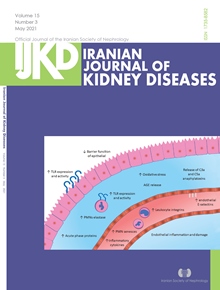Clinical Characteristics and Prognosis of Renal Thrombotic Microangiopathy in Lupus Nephritis
Abstract
Introduction. LN is an important complication affecting the prognosis of SLE. We retrospectively analysed the influence of thrombotic microangiopathy (TMA) on LN, identified risk factors of TMA in LN and renal failure in LN-TMA, and evaluated the availability of plasmapheresis. Methods. After balancing epidemiological characteristics and pathological types between groups, 127 patients (LN-TMA:42, LN:85) were included. After consulting medical records and followup data, we used the corresponding statistical methods, such as chi-squared test and Student’s t-test, to compare differences in various aspects and explore the correlation among factors. Results. LN-TMA patients had significantly higher blood urea nitrogen (13.2 mmol/L vs. 7.5 mmol/L, P < .001), systolic and diastolic blood pressures (both P < .01), serum creatinine (157.75 μmol/L vs. 79.00 μmol/L, P < .001), lactic dehydrogenase (P < .05), renal activity index (8.00 vs. 2.00; P < .001), SLE disease activity index score (13.8 ± 3.4 vs. 10.88 ± 6.0; P < .01), and pleurisy (P < .01) and lower haemoglobin (84.4 ± 20.14 vs. 99.38 ± 23.45 g/L, P < .05), platelets (87 vs. 155 ×109/L, P < .001), estimated glomerular filtration rate (39.24 vs. 97.40 mL/min/ 1.73m2, P < .05), and 3- and 5-year renal survival rates (P < .001 and P < .01, respectively) than non- TMA patients. Infection and TMA (P < 0.01) were independent risk factors for LN-TMA and renal failure, respectively. There was no obvious effect of plasmapheresis. Conclusion. TMA is an independent risk factor for renal failure in LN. As TMA affects the severity and prognosis of LN, identifying specific diagnostic indicators and effective treatment for LN is necessary.Downloads
Download data is not yet available.
Downloads
Published
2021-05-15
Issue
Section
ORIGINAL | Kidney Diseases
How to Cite
Clinical Characteristics and Prognosis of Renal Thrombotic Microangiopathy in Lupus Nephritis. (2021). Iranian Journal of Kidney Diseases, 15(3), 169-176. https://ijkd.org/index.php/ijkd/article/view/5767


